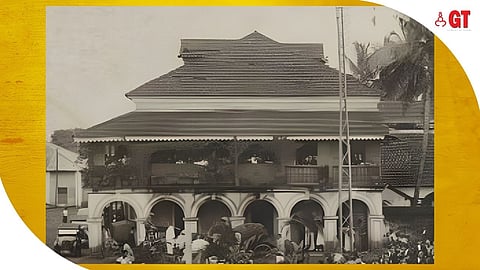

Goa is famous for its many historic monuments, especially those from the Portuguese era. One of these is the Casa da Moeda (literally translates to 'house of coins'), or the Mint House of Goa (1834-1841).
You cannot speak of Casa da Moeda without discussing the coinage of the time as it gives us some insight into Goa and Portugal’s history.
CASA DA MOEDA
The earliest known owner of the house was João Batista Goethalis (estimated around 1760 or earlier), who was in the business of selling tobacco. It later became the Fazenda Pública (treasury).
After serving its purpose as a mint, it was sold to António Inácio da Silva of Santa Cruz, who rented it to the English telegraph from 1865-1902.
In 1904, the house came to the Dias family as it was sold to the eminent Dr Miguel Caetano Dias, great grandfather of Dr Luis Dias (the present owner and resident), who was highly honoured by the Portuguese and given the title of 'General'.
He was furthermore commended and decorated for his excellent work in ridding Panjim of the bubonic plague of the time.
Portuguese chronicles present the establishment of a mint house as meeting the need of the natives to reduce the scarcity of coinage. It is said that a delegation of chiefs approached Afonso de Albuquerque for the same.
Afonso de Albuquerque saw the mint house as the consolidation of his 1510 victory over Goa.
Coins of various denominations of gold, silver and copper were struck and were known as cruzados or manueis, São Tome, in honour of St Thomas, or patacões, bazarucos and xerafins, which was the corruption of the Persian ashrafi, meaning 'noble'. There were also tangas and bastiãos.
FIRST PORTUGUESE COLONY MINT HOUSE
Goa was the first Portuguese colony to have a mint house. Malacca followed suit in 1511, and down the years, Cochin, Colombo, Bassein, Daman, Chaul and Diu acquired mint houses of their own.
The Casa da Moeda of Goa also happens to be the only Portuguese mint house of the colonies still standing today.
Initially, the mint was based in Velha Goa, or Old Goa, but in 1834, Dom Manoel de Portugal e Castro, the then Viceroy of Goa, had the mint shifted to Nova Goa, or Panjim. It is said he was unhappy with the quality of the coins, and therefore, wanted to supervise the production himself.
Since the coins were struck manually, the transfer of the mint posed no great trial. Rupias and pardaos of silver and copper reis of denominations of 10, 5 and 3 were issued to celebrate the establishment of the new mint.
Incidentally, reis, which is the plural of réal (royal), is Spanish and is reminiscent of the 1580 defeat of Portugal by Spain.
DONA MARIA II
It is interesting to note that the mint was relocated about the same time Dona Maria II was reinstated as the ruler of Portugal after her uncle, Miguel, was ousted by Pedro IV, Dona Maria’s father.
Pedro IV had previously abdicated in favour of his daughter, following which Miguel had deposed of Maria II and usurped her position.
In 1835, all coins bearing Miguel’s facsimile were withdrawn from circulation, being replaced by coins bearing the representation of Dona Maria II.
BRITISH INDIAN MINTS TAKE OVER
By the 1878 Anglo-Portuguese Convention, British Indian mints took over the minting of coins for Portuguese territories in India, and introduced uniformity in the coinage.
The superiority of the British made coins was startling in contrast to the irregular and poorly designed Portuguese Indian coins which had no edge-milling and could easily be debased by shaving off the metal.
St Thomas, the Apostle of India, was represented on all the gold coins, originally as an image and later it was replaced with the cross of St Thomas.
The Goan coins had different mint marks to denote which mint they had come from once there were other mint houses set up, for example a wheel (representing St Catherine of Alexandria), G, G-A, Goa, D-Goa, or DE-Goa.
The coins bore the likenesses of saints, especially those the issuing ruler had been named for, such as St Sebastian, St Phillip and St John.
St Thomas, the Apostle of India, was represented on all the gold coins, originally as an image, and later, it was replaced with the cross of St Thomas.
Apart from crosses and saints, the coins also had a description of the ruler of the time as being the 'Supporter of the cause of the followers of the Apostle of the merciful' or 'Helper of the cause of God'.
The Anglo-Portuguese Convention of 1880 allowed for the minting of coins destined for Goa at the Calcutta and Bombay mints. A significant monetary reform as a result of this convention was that the rupia came to be replaced by the escudo in late 1958.
Lower denominations to form the escudo were called centavos. Six escudos would make a rupee. The British issued coinage for the Portuguese in Goa that was the same value as the rupees, annas and pies in British India.
When Portugal became a republic in 1910, cupro-nickel alloy began to be used to mint rupias and bronze for tangas.
In 1882, the first paper notes of 5, 10, 20, 50, 100 and 500 were printed in London and put into circulation in 1883. But, these uniface notes were withdrawn (1896), and the next two series were printed in Panjim and had denominations up to 50.
From 1906 onwards, the currency notes were, once again, printed in London.